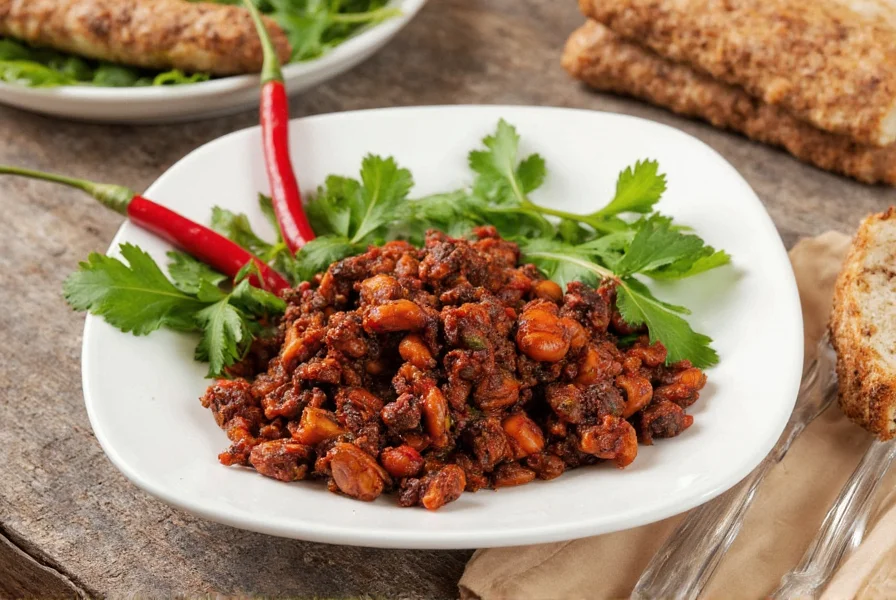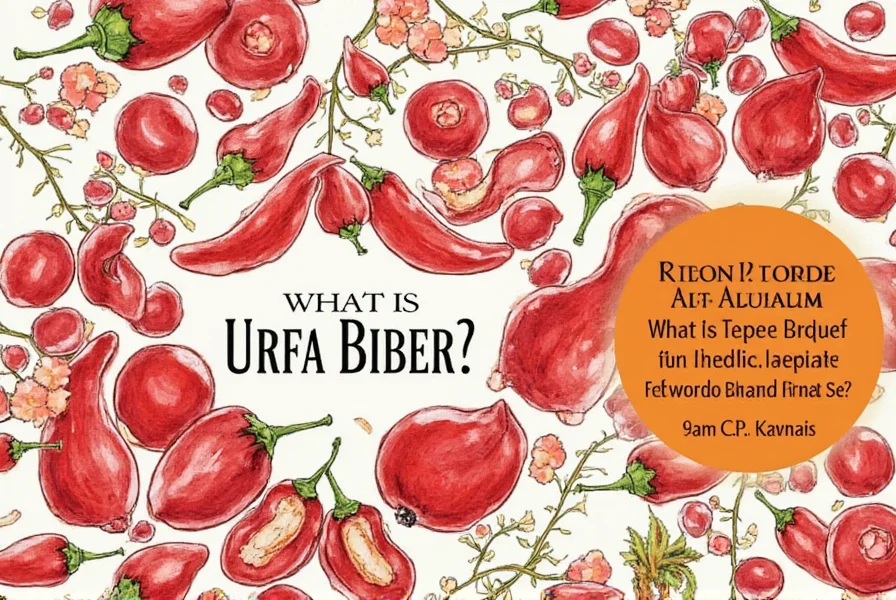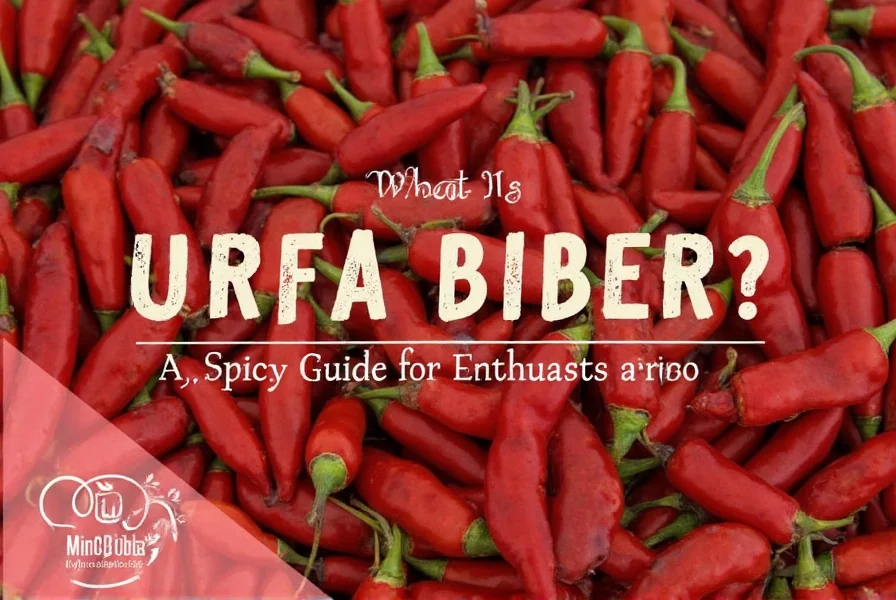Table of Contents
Introduction to Urfa Biber
Urfa Biber is a Turkish smoked chili pepper native to the Urfa region, known for its smoky, sweet flavor and moderate heat (30,000–50,000 SHU). Unlike typical hot peppers, it offers depth and complexity rather than just heat. In this guide, we'll explore its culinary uses, buying tips, and more.

What Is Urfa Biber?
Urfa Biber, also known as Urfa pepper or Turkish red pepper, is a dried chili pepper from the Capsicum annuum species cultivated specifically in Turkey's Urfa region. Its unique flavor profile comes from a traditional processing method: semi-drying, smoking, and fermentation before final drying. This process creates a spice with smoky, sweet, and slightly tangy notes—distinct from standard chili peppers that focus primarily on heat intensity.

Spice Profile of Urfa Biber
Here's a detailed breakdown of Urfa Biber's characteristics:
| Characteristic | Description |
|---|---|
| Heat Level | Medium to high (30,000–50,000 Scoville Heat Units) |
| Flavor Profile | Smoky, sweet, slightly tangy with dried fruit undertones |
| Aroma | Earthy, woodsy, with hints of cocoa and dried apricot |
| Texture | Coarse, slightly oily flakes (when ground) |
| Color | Deep burgundy to almost black when dried |
Unlike cayenne or habanero peppers, Urfa Biber's heat builds gradually and dissipates quickly, leaving a savory, complex aftertaste rather than lingering burn. This makes it ideal for enhancing dishes without overwhelming other flavors.
Culinary Uses of Urfa Biber
Urfa Biber is a staple in Turkish and Middle Eastern cuisine. Its versatility allows it to enhance both savory and sweet dishes:
1. Grilled Meats and Kebabs
Essential for authentic Turkish kebabs. Mix with olive oil, garlic, and lemon juice for marinades, or sprinkle directly on grilled lamb, chicken, or beef. Its smokiness complements charred flavors without excessive heat.
2. Soups and Stews
Add 1/4–1/2 teaspoon to tomato-based soups, lentil stews, or borscht for depth. It enhances umami without altering the dish's primary flavor profile.
3. Hummus and Dips
Stir 1/2 teaspoon into hummus or baba ganoush for a smoky twist. Pair with lemon zest and toasted pine nuts for a gourmet appetizer.
4. Spice Blends
Key ingredient in Turkish adana kebab seasoning and simit bread toppings. Combine with sumac, cumin, and smoked paprika for custom blends.
Buying Guide for Urfa Biber
Follow these expert tips to select high-quality Urfa Biber:
| Factor | What to Look For | Avoid |
|---|---|---|
| Form | Whole peppers for maximum freshness; ground for immediate use | Pre-ground versions with excessive dust or clumping |
| Color | Deep burgundy to black (not bright red) | Faded or overly orange hues |
| Smell | Strong smoky aroma with sweet fruit notes | Musty or overly pungent smells |
| Texture | Smooth flakes with slight oiliness | Dry, brittle, or powdery consistency |
| Origin | "Urfa, Turkey" or "Şanlıurfa" on packaging | Vague "Turkish pepper" labels without specific region |
Trusted brands include Turkish Spice Co. (whole peppers), Marmara Spices (ground), and Anatolian Flavors (organic options). Always check for additive-free products—pure Urfa Biber should contain only peppers.
Tips and Tricks for Using Urfa Biber
Maximize flavor with these professional techniques:
1. Toast Before Grinding
Lightly toast whole peppers in a dry skillet for 1–2 minutes to intensify smokiness. Cool completely before grinding.
2. Layer with Acidic Ingredients
Balance its sweetness with lemon juice, vinegar, or pomegranate molasses. This creates a harmonious flavor profile in dressings and sauces.
3. Use in Dry Rubs
Combine with kosher salt, black pepper, and garlic powder for steak or chicken rubs. The smokiness enhances charred edges during grilling.
4. Add to Chocolate Desserts
Surprisingly works in dark chocolate truffles or mole sauce. Start with 1/8 teaspoon per cup of chocolate for subtle complexity.

Frequently Asked Questions About Urfa Biber
What exactly is Urfa Biber?
Urfa Biber is a Turkish smoked chili pepper from the Urfa region, made from Capsicum annuum peppers that undergo semi-drying, smoking, and fermentation before final drying. This unique process creates a spice with smoky, sweet, and slightly tangy notes (30,000–50,000 SHU) that builds heat gradually rather than delivering immediate burn. Unlike cayenne or paprika, it's prized for flavor complexity over pure heat intensity.
How hot is Urfa Biber compared to other chili peppers?
At 30,000–50,000 Scoville Heat Units, Urfa Biber is hotter than standard paprika (500–1,000 SHU) but milder than cayenne (30,000–50,000 SHU) and significantly milder than habaneros (100,000–350,000 SHU). Its heat is unique—it builds slowly over 30–60 seconds and dissipates quickly, leaving a savory aftertaste rather than lingering burn. This makes it ideal for dishes where heat should enhance, not dominate, flavors.
What does Urfa Biber taste like?
Urfa Biber delivers a complex flavor profile: smoky (from the traditional drying process), sweet (reminiscent of dried apricots), and slightly tangy with earthy undertones. Many describe it as having "midnight" qualities—the heat builds gradually before fading, leaving a savory, almost meaty finish. It's often compared to a blend of smoked paprika and Aleppo pepper, but with deeper fruit notes and less acidity.
How is Urfa Biber different from Aleppo pepper?
While both are Turkish peppers, key differences exist:
- Processing: Urfa Biber is smoked and fermented; Aleppo pepper is sun-dried with oil and salt
- Flavor: Urfa Biber has deeper smokiness and cocoa-like notes; Aleppo pepper is fruitier and wine-like
- Heat: Urfa Biber (30k–50k SHU) is slightly hotter than Aleppo (10k–20k SHU)
- Color: Urfa Biber is dark burgundy/black; Aleppo is brick-red
- Texture: Urfa Biber flakes are coarser and oilier; Aleppo is finer and drier
Can I substitute Urfa Biber if I can't find it?
While no substitute perfectly replicates Urfa Biber's unique profile, these combinations work well:
- For smokiness: 2 parts smoked paprika + 1 part cayenne + pinch of cocoa powder
- For fruitiness: 1 part Aleppo pepper + 1/2 part chipotle powder
- For heat balance: 1 part sweet paprika + 1/4 part cayenne + 1/8 part sumac
How should I store Urfa Biber to keep it fresh?
Store in an airtight glass container away from light, heat, and moisture. Whole peppers retain freshness for 18–24 months; ground versions last 6–12 months. For extended shelf life, refrigerate or freeze in vacuum-sealed bags. Never store in plastic containers—oils in Urfa Biber can degrade plastic and absorb odors. Always use clean, dry utensils when handling to prevent moisture contamination.
Conclusion
Urfa Biber is more than a spice—it's a flavor enhancer that brings smoky depth, subtle sweetness, and balanced heat to any dish. Its versatility makes it indispensable for Turkish cuisine and a game-changer for home cooks exploring global flavors. Whether you're grilling kebabs, making hummus, or experimenting with chocolate desserts, Urfa Biber adds complexity without overwhelming other ingredients. Start with small amounts to appreciate its gradual heat build-up, and soon it'll become a staple in your pantry.











 浙公网安备
33010002000092号
浙公网安备
33010002000092号 浙B2-20120091-4
浙B2-20120091-4